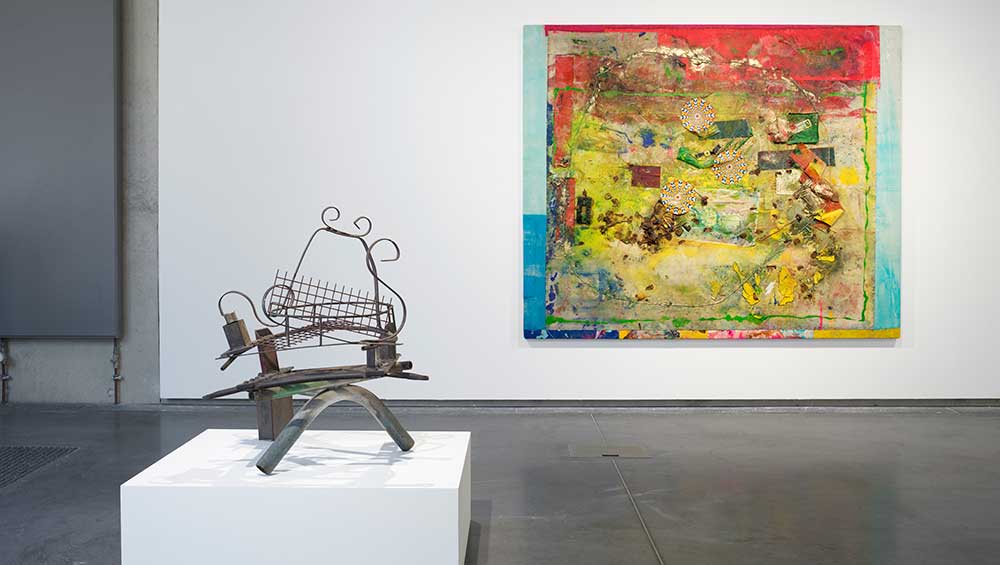
Installation view: Frank Bowling and Sculpture, The Stephen Lawrence Gallery, University of Greenwich, London, 15 July – 3 September 2022. © Frank Bowling. All rights reserved DACS 2022. Courtesy the artist. Photo: Peter Mallet.
Stephen Lawrence Gallery, University of Greenwich, London
15 July – 3 September 2022
by JOE LLOYD
For more than six decades now, Frank Bowling (b1934) has been a painter. The Guyana-born British artist is celebrated for his big, bold abstract canvases that stretch paint to its expressive limits. In the 60s, he became a leading colour field painter, extending a tradition begun by the abstract expressionists. Yet although painting is Bowling’s primary medium, it is not his only one. In the late 80s, he was asked if he would like to show his paintings alongside the works of a contemporary sculptor. He replied that he would make the sculptures himself, and set about creating art out of scrap metal.
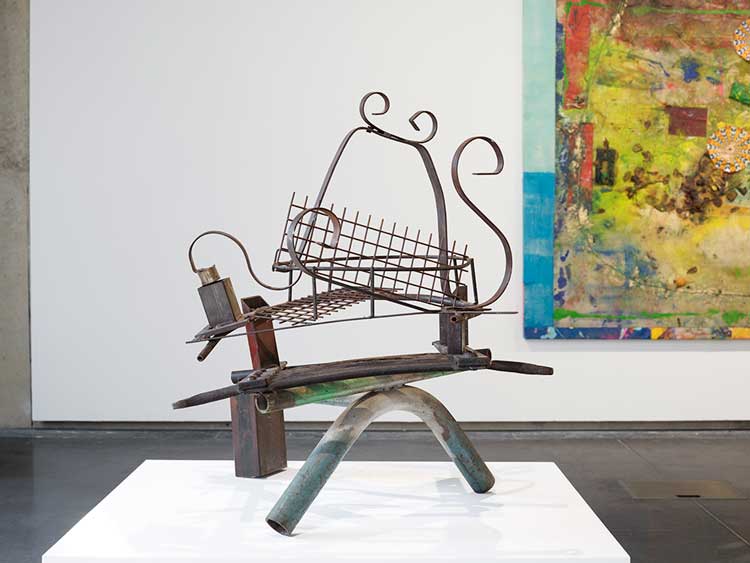
Frank Bowling. The Man Who Mistook His Wife for a Hat, 1988.
Welded steel, 75 x 72 x 65 cm. Installation view: Frank Bowling and Sculpture, The Stephen Lawrence Gallery, University of Greenwich, London, 15 July – 3 September 2022. © Frank Bowling. All rights reserved DACS 2022. Courtesy the artist. Photo: Peter Mallet.
These were shown at a 1988-89 exhibition, which toured Britain and Ireland. They have lived in Bowling’s apartment in Pimlico, south-west London, ever since, with few airings. His son, Ben Bowling, writes: “For the last 30 years, Frank Bowling’s welded-steel sculptures were just part of the furniture of the family home. King Crabbé stood like a sentinel guarding the first-floor staircase. The Man Who Mistook His Wife for a Hat, adorned with a planter’s pith helmet and a hand-knitted sock, stood at the doorway to the living room, while Bulbul sat next to the television. In the kitchen, Hrund lurked behind the fridge. Upstairs, Angharad’s Gift Patagonia rested on an oak chest in the bedroom, its steel sculpture acting like a magnet for the ephemera of domestic life.”
A new exhibition at the University of Greenwich’s Stephen Lawrence Gallery, Frank Bowling and Sculpture, shines a light on a hitherto under-explored aspect of his practice. It presents seven of Bowling’s scrap metal sculptures alongside a career-spanning selection of paintings. The exhibition has been curated by Sam Cornish. It accompanies Cornish’s new monograph Frank Bowling: Sculpture (published by Ridinghouse, £35), which untangles Bowling’s relationship with the medium through all stages of his artistic practice.
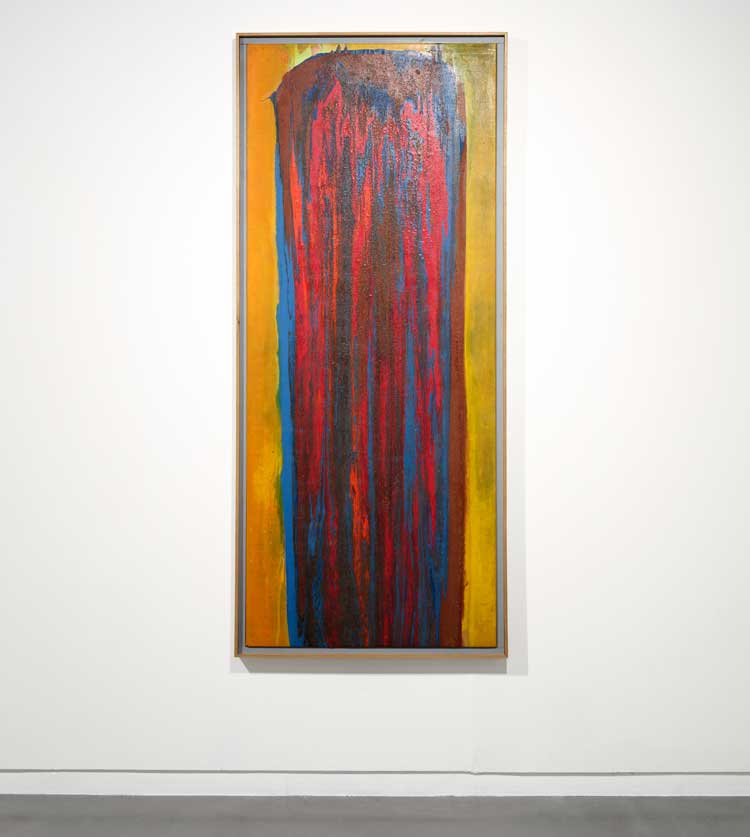
Frank Bowling. Sentinel, 1976. Acrylic on canvas, 172.72 x 71.12 cm. Installation view: Frank Bowling and Sculpture, The Stephen Lawrence Gallery, University of Greenwich, London, 15 July – 3 September 2022. © Frank Bowling. All rights reserved DACS 2022. Courtesy the artist. Photo: Peter Mallet.
Sculpture has a continuous presence in Bowling’s oeuvre. A trio of early paintings depicting a bloody, decomposing Sheep’s Head (1960) seem to turn the animal into a stone-like sculptural volume. Many of his poured paintings of the 70s resemble standing stones, one of the most ancient sculptural forms. An example at the Stephen Lawrence Gallery, Sentinel (1976), looms almost to the top of the canvas, with streaks of red, black and blue popping out above a yellow background.
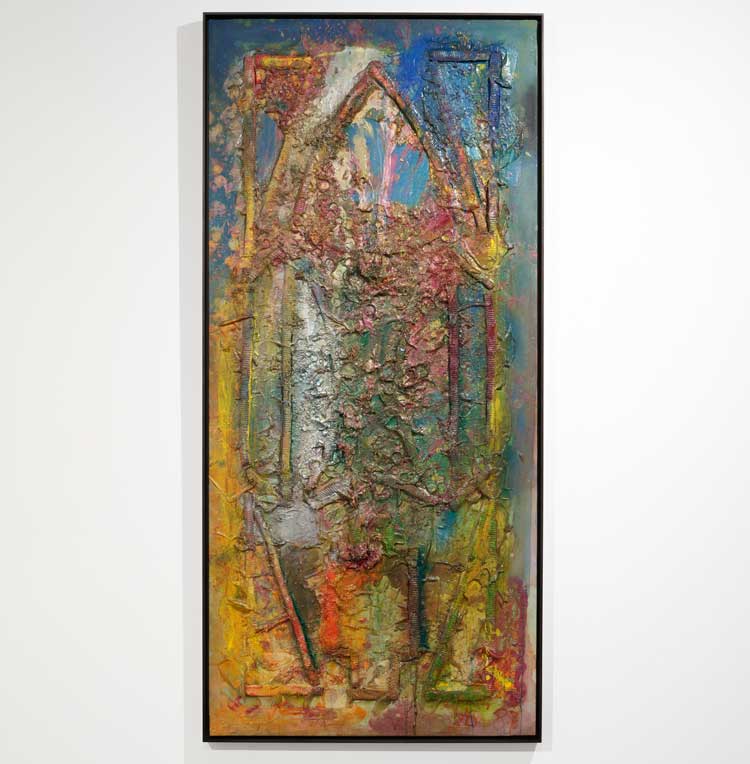
Frank Bowling. Ancestor Window, 1987. Acrylic paint, acrylic gel and found additions on canvas, 188.4 x 86.1 cm. Installation view: Frank Bowling and Sculpture, The Stephen Lawrence Gallery, University of Greenwich, London, 15 July – 3 September 2022. © Frank Bowling. All rights reserved DACS 2022. Courtesy the artist. Photo: Peter Mallet.
His engagement became even more explicit in the 80s, when he turned to “sculptural paintings”. These feature strips of foam and other found objects attached to the canvas and coated in paint and other materials. At the Stephen Lawrence Gallery, Ancestor Window (1987) traces a gothic window frame formed from foam additions, while Mummybelli (2019) incorporates numerous items, including a letter, roses and a tube of medical cream. Other works use gel to create a relief-like effect. The pearlescent Brooklyn III (1993/2004) has an extraordinarily layered surface from acrylic and gel alone.
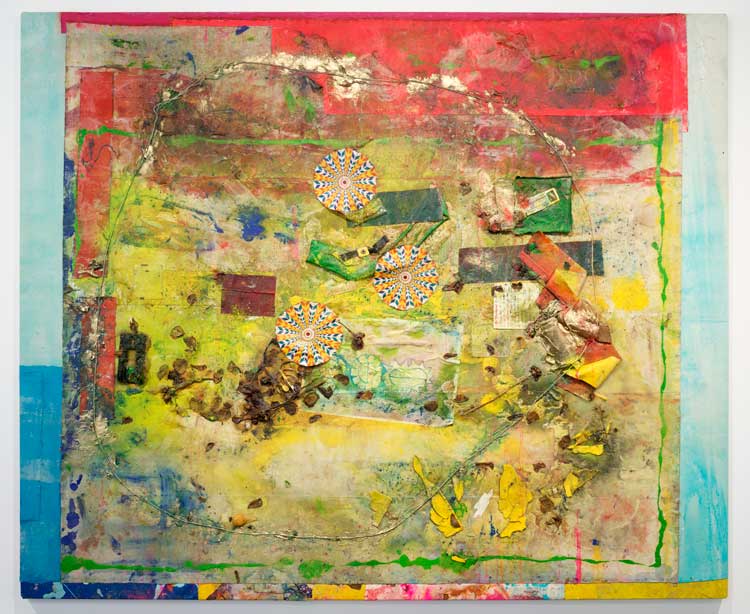
Frank Bowling. Mummybelli, 2019. Acrylic, acrylic gel and found objects on canvas with marouflage, 171.3 x 206.8 cm. Installation view: Frank Bowling and Sculpture, The Stephen Lawrence Gallery, University of Greenwich, London, 15 July – 3 September 2022. © Frank Bowling. All rights reserved DACS 2022. Courtesy the artist. Photo: Peter Mallet.
Despite the sculptural subjects and intimations of Bowling’s paintings, however, the sculptures have never quite received their due. “There has been almost complete silence around Bowling’s own sculptures,” Cornish writes. There was not one in Tate Britain’s voluminous 2019 retrospective. Currently, 17 survive, the earliest dating from the 70s and the most recent from this year. Others were left outside Bowling’s flat and stolen, probably returning to scrap.
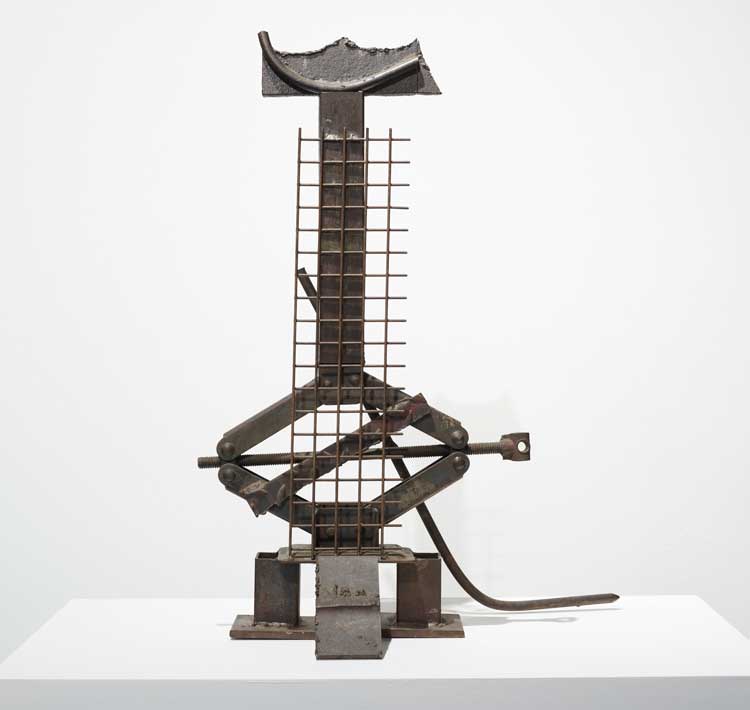
Frank Bowling. King Crabbé, 1988
Welded steel, 68 x 50 x 30 cm. Installation view: Frank Bowling and Sculpture, The Stephen Lawrence Gallery, University of Greenwich, London, 15 July – 3 September 2022. © Frank Bowling. All rights reserved DACS 2022. Courtesy the artist. Photo: Peter Mallet.
Bowling’s sculptures are experiments. He arranged them partly for amusement, partly to experiment with geometry. “The sculptures themselves,” writes Cornish, “retain a sense of the expedient, rather offhand manner with which Bowling approached their construction.” The seven sculptures in Greenwich demonstrate this freedom and playfulness. “They’re things,” Bowling wrote in a catalogue for the 1988 exhibition, “that took my fancy. They suggest possibilities for invention and movement.”
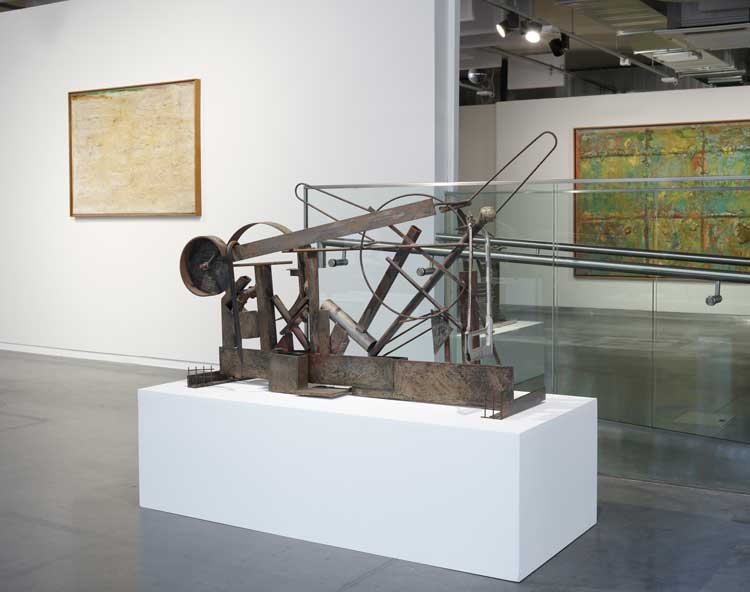
Frank Bowling. Hrund, 1988. Welded steel, 84 x 122 x 40 cm. Installation view: Frank Bowling and Sculpture, The Stephen Lawrence Gallery, University of Greenwich, London, 15 July – 3 September 2022. © Frank Bowling. All rights reserved DACS 2022. Courtesy the artist. Photo: Peter Mallet.
Bowling is both constrained by the objects he finds and free to assemble them how he pleases. King Crabbé (1988) includes a forbidding clamp and is topped by a fragment of metal that resembles the bottom of a grinning face. Hrund (1988) could be a forgotten device from the Industrial Revolution. Its metal surface is scratched and worn, so that it almost looks as if it has been painted on. The Man Who Mistook His Wife for a Hat (1988) — presumably named after the 1985 Oliver Sacks book — appears almost like a portrait of the titular character. But it is also an assemblage of geometries, a three-dimensional constructivism.
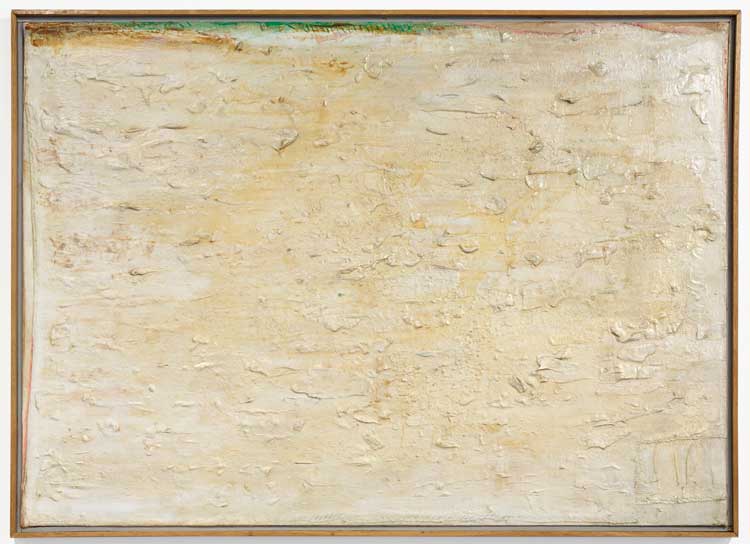
Frank Bowling. Brooklyn III, 1993/2004. Acrylic paint and acrylic gel on collaged canvas, 83 x 115.5 cm. Installation view: Frank Bowling and Sculpture, The Stephen Lawrence Gallery, University of Greenwich, London, 15 July – 3 September 2022. © Frank Bowling. All rights reserved DACS 2022. Courtesy the artist. Photo: Peter Mallet.
As well as an artistic modernism, there’s also something of literary modernism about them. They are ragged claws scuttling across the floors of silent workshops. They could be inexplicable torture machines in Kafka’s penal colony, or Bruno Schulz’s living household objects. The pieces of scrap that Bowling assembled often feature spikes and grills. What is useful in the home can also be a hazard, as well as a spur for nightmares.
When examining Bowling’s practice of assemblage, the artist that immediately leapt to mind was Anthony Caro, the British high modernist who bolted and welded pieces of steel together into monumental forms. Cornish tracks in detail the complex relationship between these two men. Bowling was galvanised by the Hayward Gallery’s 1969 Caro retrospective. “After Caro,” Bowling later reflected, “there seemed no point learning about sculpture. The thing about sculpture was to sit back and enjoy it.” But Bowling also had misgivings about Caro as both man and artist, which flared up when Caro asked him to contribute art to an exhibition funding a school in South Africa. Bowling found the project, in Cornish’s phase, “condescending and colonial”.
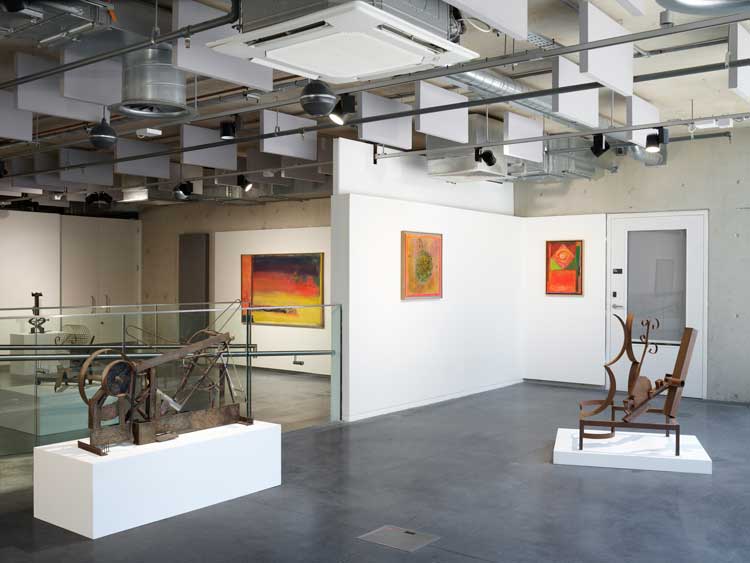
Installation view: Frank Bowling and Sculpture, The Stephen Lawrence Gallery, University of Greenwich, London, 15 July – 3 September 2022. © Frank Bowling. All rights reserved DACS 2022. Courtesy the artist. Photo: Peter Mallet.
Bowling has also maintained a friendship with the American sculptor Melvin Edwards, whose abstract steel works look at the horrors of black history. But though he has more of a political affinity with Edwards, Bowling’s sculpture seems closer to Caro’s, objects to sit back and enjoy rather than scrutinise. A recent work, What Else Can You Put in a Judd Box (2022), is a fun joke at Donald Judd’s expense: a hollow cuboid made of curving metal elements that would be unlikely to please the straight line-obsessed conceptualist. But for anyone else, it is pleasing indeed.